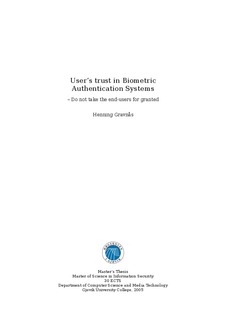User’s trust in Biometric Authentication Systems – Do not take the end-users for granted
Master thesis
Permanent lenke
http://hdl.handle.net/11250/143761Utgivelsesdato
2005Metadata
Vis full innførselSamlinger
Sammendrag
NORSK:
I de senere årene har mediefokuset vært rettet mot sikkerhet. Et av kravene innenfor sikkerhet, er økt
behov for korrekt autentisering av en person. Det er mulig å autentisere seg ved å fremlegge bevis på noe
du vet (for eksempel et passord), noe du har (for eksempel et ID-kort) eller noe du er (for eksempel
biometri). Denne undersøkelsen forsøker å finne ut av i hvilken grad mulige brukere av biometriske
autentiseringssystemer har tillit til et slikt system. Deltakerne i denne undersøkelsen har besvart ulike
spørsmål om dette temaet, og har i tillegg sett hvordan et biometrisk autentiseringssystem virker og
hvordan det kan lures. For å lure systemet ble deltakernes fingeravtrykk kopiert ved bruk av en enkel
metode beskrevet i rapporten. Resultatene fra undersøkelsen har så blitt analysert og diskutert mot tre
hypoteser som påstår at en bruker av et biometrisk autentiseringssystem lett vil få tillit til det, men at
tilliten svekkes når man ser hvor lett systemet kan lures. Undersøkelsen viser brukernes tillit til de mest
vanlige biometriske teknikkene, og hvordan tilliten endres når svakhetene ved en av dem demonstreres. ENGELSK:
The last years there has been a stronger focus on security in the media all over the world. One of the
important issues in security is the need of correctly authenticate a person. This is possible either by
providing something you know (e.g. password), something you have (e.g. ID-card), or something you
are (e.g. biometrics). This study explores to what extent possible users of a biometric authentication
system have trust in such a system. The participants in this study have answered several questions
regarding the issue, as well as witnessed how a biometric authentication system works and how it can be
fooled. By using a simple method of making artificial fingerprints, the system was fooled. The method is
described in this report. The results from the questionnaires have been analyzed and discussed against
three hypotheses which allege that a user quickly will accept and have trust in a biometric
authentication system. The hypotheses also allege that the user will change his or her trust when
witnessing how easily such a system can be fooled. The study shows the users trust for the most
common biometric techniques, and how the trust changes when the weaknesses of one of them are
demonstrated.
